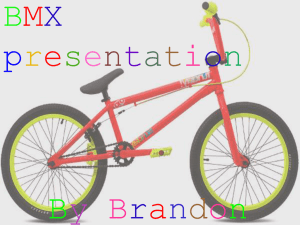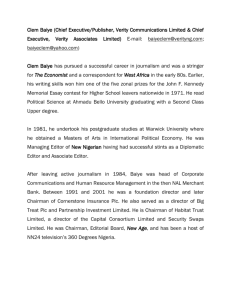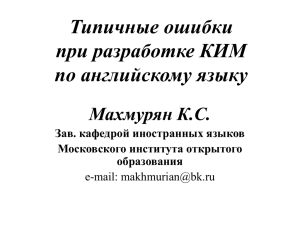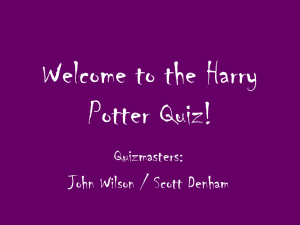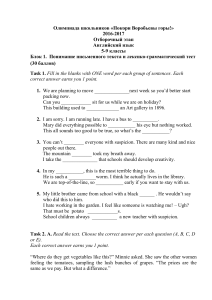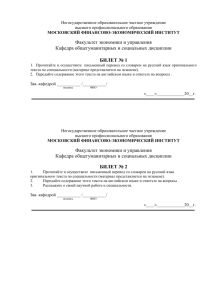9-11 классы
advertisement
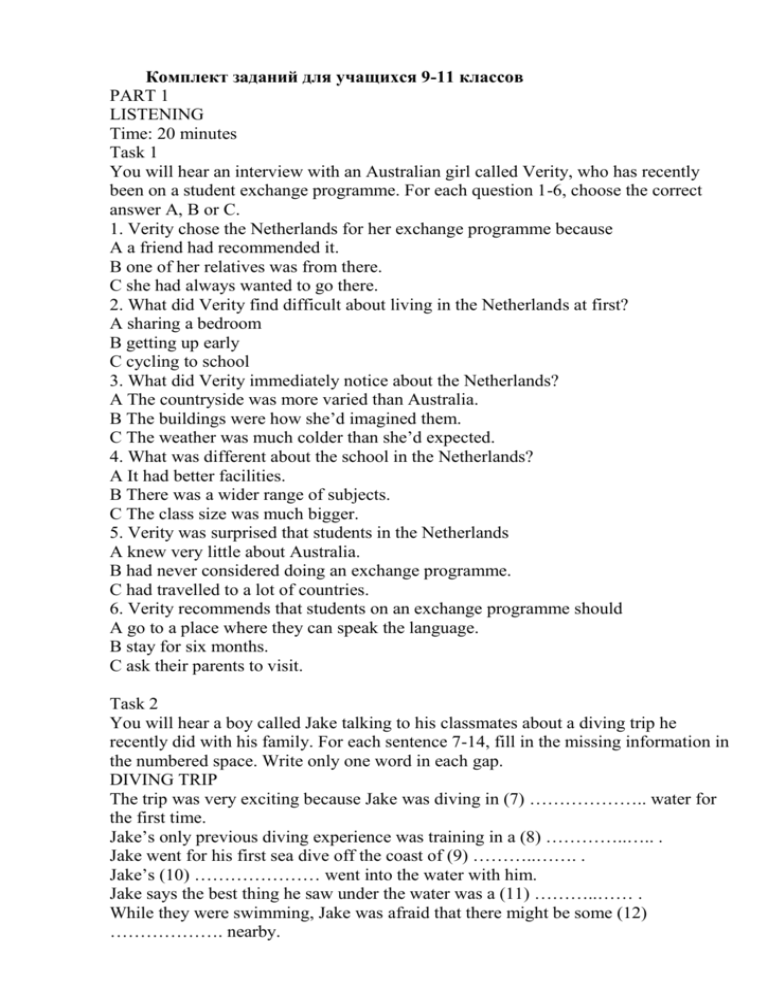
Комплект заданий для учащихся 9-11 классов PART 1 LISTENING Time: 20 minutes Task 1 You will hear an interview with an Australian girl called Verity, who has recently been on a student exchange programme. For each question 1-6, choose the correct answer A, B or C. 1. Verity chose the Netherlands for her exchange programme because A a friend had recommended it. B one of her relatives was from there. C she had always wanted to go there. 2. What did Verity find difficult about living in the Netherlands at first? A sharing a bedroom B getting up early C cycling to school 3. What did Verity immediately notice about the Netherlands? A The countryside was more varied than Australia. B The buildings were how she’d imagined them. C The weather was much colder than she’d expected. 4. What was different about the school in the Netherlands? A It had better facilities. B There was a wider range of subjects. C The class size was much bigger. 5. Verity was surprised that students in the Netherlands A knew very little about Australia. B had never considered doing an exchange programme. C had travelled to a lot of countries. 6. Verity recommends that students on an exchange programme should A go to a place where they can speak the language. B stay for six months. C ask their parents to visit. Task 2 You will hear a boy called Jake talking to his classmates about a diving trip he recently did with his family. For each sentence 7-14, fill in the missing information in the numbered space. Write only one word in each gap. DIVING TRIP The trip was very exciting because Jake was diving in (7) ……………….. water for the first time. Jake’s only previous diving experience was training in a (8) …………..….. . Jake went for his first sea dive off the coast of (9) ………..……. . Jake’s (10) ………………… went into the water with him. Jake says the best thing he saw under the water was a (11) ………..…… . While they were swimming, Jake was afraid that there might be some (12) ………………. nearby. However, he discovered that the big creatures he saw were (13) ………..……… . Jake managed to do (14) ……………….. dives in total. Task 3 You will hear a conversation between a boy, Harry, and a girl, Laura, about wildlife photography. Look at statements 15-20 below. Decide if each statement is true or false. Put a tick (v) in the corresponding box. № Statement TRUE FALSE 15. Harry admires the wildlife photo of a fish in ‘Animals’ magazine. 16. Harry thinks the unusual creatures in Laura’s photos are what makes them good. 17. Laura and Harry find it’s hard to keep still when taking wildlife photos. 18. Harry doubts whether his camera is good enough for wildlife photography. 19. Laura thinks it’s important to get up early to take wildlife photos. 20. Laura and Harry are both considering getting more instruction in photography. PART 2 READING Time: 20 minutes Task 1 Read the text and questions 1-5 below. For each question, mark the correct letter A,B, C or D. MY HOME IS A WINDMILL by Josh Summers, aged 14 My home’s different from where my friends live because I live in a19th century windmill! My parents saw it one day, and bought it. It was in poor condition, but it was repaired and now it’s fantastic! The windmill was once used to make flour from corn. The corn store used to be downstairs, where our kitchen is now, and horses came there to deliver the corn. The enormous 20-metre sails are still on the front, but they don’t turn in the wind like they used to because it’s too dangerous, so birds live in them instead. There’s always a ladder up the side of the windmill so that dad can paint it and keep it a nice cream colour. He also cleans the windows, although a company comes to do the top ones as the ladder’s too short. Inside it’s like a tent with six sides, and it becomes more pointed towards the top, so the rooms get smaller. My room’s under the roof and I get a fantastic view – it’s like looking out of an airplane window. There are some other houses around now, and a new main road, but I can relax and make a noise when I play my guitar up there and no one can hear me! I can hear everything, though, like the birds when it’s quiet, which is really calming, or the very loud storms, which I can see coming towards us. And I actually find it easier to concentrate on my school work up there, as my brothers and sisters don’t want to climb up all the stairs, so they don’t disturb me! I can’t imagine living anywhere else! 1. What is Josh trying to do in the text? A compare his home with his friends’ homes B explain why his family chose to live in their current home C tell readers about advantages of living where he does D suggest how his home could be improved 2. What does Josh say about the outside of the windmill? A Wild creatures have made their homes there. B It’s covered in dark paint. C There’s a ladder that goes right to the top. D The windows frequently need cleaning. 3. Josh says that his room A is a bit like an aeroplane inside. B is a good place for practicing a musical instrument. C is the largest one in the windmill. D is better for relaxing in than doing school work. 4. What does Josh say about the different sounds he hears in the windmill? A He dislikes the noise of the sails in the wind. B He enjoys listening to all the birds. C He feels nervous when a loud storm comes along. D He’s pleased that he’s not disturbed by any noise. 5. What would a visitor from the 19th century say if they saw the windmill now? A It’s great that they’ve kept the corn store as it was. The horses used to love coming there. B The sails are a lot smaller than they used to be. I suppose that’s for safety reasons. C It’s still in the same condition as before. The owners never looked after it then, either. D You can still see the windmill from miles away. Of course, there weren’t all these buildings around it then, as a busy road going past. Task 2 Read the text and mark statements 6-12 below as T (true) or F (false). On 2 November 1982, the British public turned on their television sets for the arrival of the nation’s fourth TV station, called Channel 4. They were greeted by the smiling face of local TV news presenter Richard Whiteley, who welcomed them with the words: ‘As the countdown to a new channel ends, a brand new countdown begins.’ And with this sentence, the words and numbers game show ‘Countdown’ was launched. The rules of this new game show were as follows: two contestants faced each other over several rounds of games with letters and with numbers. Finally, there was the Conundrum round, where contestants had to work out the nine-letter anagram. At the end of the show, the contestant with the highest score won and was invited back the next day to face a new challenger. However, despite the simplicity of the rules, those who watched the early editions of the 30-minute show, which was on five days a week, could hardly have imagined that it would last any longer than the original seven weeks that had been planned for it. The first contestants and guests were not exactly the most exciting people on television. But luckily for ‘Countdown’, there were enough old people, university students and other people with nothing much to do each afternoon to keep the show alive. When the show began, Carol Vorderman won over fans with her amazing mathematical abilities. ’Countdown’ made a celebrity out of Carol, and these days she’s a familiar face on British TV. Despite her fame, Carol still loyally turned up on ‘Countdown’ each day to turn over the letters and show the contestants how to solve the numbers game until she retired in 2008. Yes, that is correct – nearly 30 years since it began, ‘Countdown’ continues to keep its audience’s brains working every afternoon. In fact, on 3 January 2006, it celebrated its 4,000th show. Other signs of its success include the increase in the length of each programme to 45 minutes, the addition of a show on Saturdays and the number of British celebrities who have made an appearance. 6. ‘Countdown’ was the first programme ever shown on Channel 4. 7. Every day two new contestants compete to become ‘Countdown’ champion. 8. Originally only 35 programmes of ‘Countdown’ were planned. 9. The early shows were popular with working people. 10. Carol Vorderman is no longer involved with the show. 11. These days ‘Countdown’ is on for four and a half hours every week. 12. More and more famous people like turning up on the programme. Task 3 Read the text and match sentences 13-20 below with paragraphs A-F of the text. The History of BMX Biking A. BMX biking began in the late 1960s in southern California. It’s based on the sport of motocross, which dates back to 1924 and involves racing motorbikes across rough tracks. It started when children began to copy motocross riders by racing their bikes on tracks which they built themselves. This new form of bike racing was named bicycle motocross, or BMX. B. In July 1971, a movie about motocross called ‘On Any Sunday’ came out. At the start of the film a group of kids from California are shown riding their bicycles as if they were riding motorbikes. This helped to make BMX biking more popular. Soon BMX races attracted hundreds of riders. C. In the late 1960s and early 1970s, the most famous BMX bike was the Schwinn Sting-Ray; this was the bike every young rider wanted to own. At this time 70 per cent of all bicycle sales in the USA were either the Sting-Ray or similar models. By the mid 1970s BMX design had improved a lot and there were many new models to choose from. But the bikes all had the same sized wheels and usually only one brake. D. In 1977, the American Bicycle Association was formed to organize the competitions and to make the rules. The sport was also becoming popular in other parts of the world, particularly in Europe. The first BMX world championship was held in Indianapolis, USA, in 1978. Most of the 165 competitors were teenagers, but there were also children competing in special races for the under 8s and under 12s. There were separate races for boys and girls. There weren’t many nationalities present at this competition; apart from Americans there were only a few riders from Australia, Japan and Venezuela. E. Since that time the number of races for adults has grown very quickly, but BMX racing didn’t become a full Olympic sport until the 2008 Summer Olympics in Beijing. Maris Stromberg from Latvia won the first ever Olympic men’s gold medal for BMX racing and Anne-Caroline Chausson from France became the first women’s champion. F. As the popularity of BMX grew, riders were constantly testing the limits of their bikes. BMX wasn’t just about racing any more. Riders began to take their bikes to skateboard parks and started performing tricks and jumps. This became known as ‘freestyle’ and riders soon began to practice this as much as racing. 13. There were races for different age groups at the first BMX world championships. 14. BMX freestyle started because BMX riders wanted new challenges. 15. BMX biking was invented by children. 16. The Schwinn Sting-Ray was the favourite model of BMX riders to begin with. 17. More BMX bikes were sold than any other type of bike in the USA in the early 1970s. 18. Many people learned about BMX biking from a film. 19. BMX biking appeared more than 40 years after its prototype – motocross. 20. Some riders from Asia and Latin America took part in the first BMX world championship. PART 3 USE OF ENGLISH Time: 10 minutes Task 1 Match sentences 1-10 with the way (a-k) each person is travelling in Great Britain. There is one extra means of travelling. 1. I am often called to rescue people, because I can take off and land in difficult places. 2. When the traffic lights turned green, my dad drove away. 3. I got a flat tyre as I was on my way to school. 4. We had to wait for ages on the platform. 5. You get a seat upstairs and I’ll buy a ticket from the driver. 6. The waves are coming right over the side, so we’re all getting wet! 7. The driver will take us to our door, and we’ll pay when we get there. 8. I go very fast when I’m riding this, so it’s dangerous not to wear a helmet. 9. After we’d all got in, the door shut and we dived down under the water. 10. We climbed into the basket and took off from a field – it was really quiet! a motorcycle b boat c train d helicopter e submarine f hot air balloon g bus h car i bicycle j taxi k airplane Task 2 For questions 1-10, read the text below and choose A, B, C or D to fill in the gaps. J.K. Rowling is the author of a successful series of books. She uses the initials J.K. because her publishers thought that a book by a woman might not appeal _________(11) boys. Rowling was born in 1965 and brought up in England and South Wales. After she finished university, she got a job in London. In 1990, while she was traveling from Manchester to London, her train was held _________ (12) and during the four-hour delay she got the idea of writing about a young wizard. In 1991 she ________ (13) to Portugal, where she had a job teaching English, and she ___________ (14) the manuscript for the first Harry Potter book with her. She returned to Britain in 1993 and carried _______ (15) writing it. Rowling completed Harry Potter and The Philosopher’s Stone in 1995. Twelve publishers turned _________ (16) before Bloomsbury agreed to publish it. The decision was apparently ________ (17) by the young daughter of the company’s chairman, who loved the first chapter of the book. In 1995 Bloomsbury advised Rowling that she had little chance _________ (18) making money writing children’s books. Today she has a fortune of around $ 1 billion. Rowling believes that people who have a lot of money should ________ (19)sure they use it responsibly. For this reason, she has given ________(20) millions of dollars to charitable causes. 11 A for B of C on D to 12 A up B on C in D back 13 A arrived B left C reached D went 14 A brought B fetched C came D took 15 A off B on C over D through 16 A it down B down it C it up D up it 17 A had B done C given D made 18 A to B for C of D about 19 A do B make C have D get 20 A away B back C in D out ID NUMBER PART 4 WRITING Time: 20 minutes Comment on the following statement. Some people think that computer games are better than life. What is your opinion? Do you agree with this statement? Write 100 -120 words. Remember to - make an introduction - express your personal opinion and give reasons for your opinion - make a conclusion. ____________________________________________________________________ ____________________________________________________________________ ____________________________________________________________________ Критерии оценивания и подсчет баллов WRITING - КРИТЕРИИ ОЦЕНИВАНИЯ Максимальное количество баллов: 20 Внимание! При оценке 0 по критерию "Содержание" выставляется общая оценка 0. БАЛЛЫ (засодержание) СОДЕРЖАНИЕ (максимум 10 баллов) ОФОРМЛЕНИЕ (максимум 8 баллов) Композиция(максимум 2 балла) Лексика(максимум 3 балла) Грамматика(максимум 3 балла) Орфография и пунктуация(максимум 2 балла) 9-10 Коммуникативная задача полностью выполнена с учетом цели высказывания и адресата. Тема раскрыта полностью. Участник демонстрирует оригинальный подход к раскрытию темы. 2 балла Работа не имеет ошибок с точки зрения композиции. 3 балла Участник демонстрирует богатый лексический запас, необходимый для раскрытия темы, точный выбор слов и адекватное владение лексической сочетаемостью. Работа не имеет ошибок с точки зрения лексического оформления. 3 балла Участник демонстрирует грамотное и уместное употребление структур, необходимых для раскрытия темы. Работа не имеет ошибок с точки зрения грамматического оформления. 2 балла Участник демонстрирует уверенное владение навыками орфографии и пунктуации. Работа не имеет ошибок с точки зрения орфографического и пунктуационного оформления. 78 Коммуникативная задача выполнена с учетом цели высказывания и адресата. Тема раскрыта полностью, однако в работе не хватает оригинальности в раскрытии темы. 1 балл В целом текст имеет четкую структуру, соответствующую заданной теме. Текст разделен на абзацы. В тексте присутствуют связующие элементы. Допустимы незначительные нарушения структуры, логики или связности текста 2 балла В целом лексический состав текста соответствует заданной теме, однако имеются неточности в выборе слов и лексической сочетаемости (1-2), которые не затрудняют понимания текста. Или: используется стандартная, однообразная лексика. 2 балла В тексте присутствует ряд незначительных грамматических и/или синтаксических ошибок, не затрудняющих общего понимания текста (1-2). 1 балл В тексте присутствуют орфографические и/или пунктуационные ошибки, которые не затрудняют общего понимания текста (1 -3). 5-6 Коммуникативная задача в целом выполнена, однако имеются отдельные нарушения целостности содержания. Тема раскрыта не полностью: не приведены все необходимые аргументы и/или факты. 1 балл В целом лексический состав текста соответствует заданной теме, однако имеются ошибки в выборе слов и лексической сочетаемости (3-5), которые не затрудняют понимания текста. 1 балл В тексте присутствует ряд грамматических и/или синтаксических ошибок, не затрудняющих общего понимания текста (3-5). 3-4 Коммуникативная задач выполнена частично. Содержание текста не полностью отвечает заданной теме .0 баллов Текст не имеет четкой логической структуры. Отсутствует или 0 баллов Имеются многочисленные ошибки в употреблении лексики, затрудняющие 0 баллов В тексте присутствуют многочисленные ошибки, затрудняющие его понимание 0 баллов В тексте присутствуют многочисленные орфографические 0-2 Коммуникативная задача не выполнена. Содержание текста не отвечает заданной теме. или объем работы менее 50% от заданного.4 неправильно выполнено абзацное членение текста. Имеются серьезные нарушения связности текста и/или многочисленные ошибки в употреблении логических средств связи. понимание текста (больше 5). (больше 5 ). и/или пунктуационные ошибки, затрудняющие его понимание (больше 3). 4 При превышении объема более, чем на 10% от заданного (140 слов и более), проверяются первые 120 слов. При превышении объема менее, чем на 10% от заданного, баллы за содержание не снижаются. Процедура проверки работ в конкурсе письменной речи Каждая работа проверяется в обязательном порядке двумя членами жюри независимо друг от друга (каждый член жюри получает чистую копию работы без каких-либо пометок). Члены жюри записывают замечания и выставляют баллы не в работе, а в своем бланке протокола. Итоговым баллом является средний балл между баллами, выставленными двумя членами жюри, проверяющими работу. В случае значительного расхождения выставленных оценок (расхождение оценок более 3-х баллов), назначается еще одна проверка, затем выставляется средняя оценка между двумя ближайшими баллами (третья оценка при этом не учитывается). Если после третьей проверки все три оценки значительно расходятся (расхождение оценок более 3-х баллов), работа считается «спорной». «Спорные» работы проверяются и обсуждаются коллективно. ПРОТОКОЛ ОЦЕНКИ КОНКУРСА «ПИСЬМО» Максимальное количество баллов, которое можно получить за конкурс Writing - 20 (двадцать). Эксперт № __________________________ ID участника К1 содержание К2лексика К3грамматика К4орфография Сумма баллов (мах 20 ) Общий подсчет баллов Количество и тип задания (все задания по уровню сложности соответствуют B1B2 по шкале Совета Европы) Количество баллов Время выполнения раздела 1 Аудирование 1. Заполнение на выбор ответа из четырех предложенных 2. Задание на заполнение пропусков 3. Задание на соотнесение информации. Альтернативный выбор (T – F). 6 8 6 20 мин. 2 Чтение 1. Задание на полное понимание текста с выбором ответа из четырех предложенных 2. Задание на соотнесение информации. Альтернативный выбор (T – F). 3. Чтение текста с пониманием общего содержания, задание на соотнесение информации. 5 7 8 20 мин. 3 Лексико- грамматический тест 1. Задание на установление соответствия (выбор из меню) 2. Задание на выбор правильного ответа из четырех предложенных. 10 10 10 мин. 4 Письмо Продуктивное письменное высказывание в формате эссе (объем 100-120 слов). 20 20 мин. ИТОГО 80 70 минут Ключи и транскрипция текстов для аудирования LISTENING Task 1 1C 2C 3B 4A 5B 6B 65 Task 2 7 open 8 pool 9 the USA 10 cousin 11 ship 12 sharks 13 dolphins 14 eleven/11 Task 3 15B 16B 17A 18A 19B 20A READING Task 1 1C 2A 3B 4B 5D Task 2 6 T 7 F 8 T 9 F 10 T 11 T 12 T Task 3 13 D 14 F 15 A 16 C 17 C 18 B 19 A 20 D USE OF ENGLISH Task 1 1d 2h 3i 4c 5g 6b 7j 8a 9e 10f Task 2 11 D 12 A 13 D 14 D 15 B 16 A 17 D 18 C 19 B 20 A Script Task 1 You will hear an interview with an Australian girl called Verity, who has recently been on a student exchange programme. For each question 1 to 6, choose the correct answer A, B or C. You now have 20 seconds to look at questions 1 to 6. Now we are ready to start. Listen carefully. You will hear the recording twice. Interviewer: With me in the studio is Verity Meehan, who’s recently returned from a six-month exchange programme with a family in the Netherlands. That’s a long way from home, Verity. Why did you choose to do your exchange programme there? Verity: Well, none of my friends had been there or anything like that but my grandfather spent some time there when he was young and he said I should visit one day and I’d planned to do that as soon as I could. So when I had the opportunity to go to Europe, it seemed like the obvious place to go. Interviewer: But you were only 15. Was there anything you found difficult about living in a foreign country? Verity: Well, the family I stayed with in the Netherlands were really kind. And I wasn’t lonely because I shared a room with one of their daughters. She helped me get used to my new routine, made sure I got up in time and things like that. The only thing that was hard was the one-kilometre bike ride to school every day! I enjoyed it in the summer but in winter it was terrible. Interviewer: So, when you arrived, what did you notice straight away about the Netherlands? Verity: Well, I remember the first few hours really clearly. I knew the weather wouldn’t be warm because it was winter, but it wasn’t as bad as I’d thought it would be. The family met me at the airport and we drove to their village. I was a bit disappointed by the countryside – it looks much nicer in summer – but I was so excited when I saw all the old buildings there. They looked exactly how I thought they would. Interviewer: And what was the school like? Verity: It was OK because there were a lot of classes in English. And they gave me projects to do when there were subjects in Dutch I couldn’t understand. The school was very modern and much bigger than most schools in Australia. The library was fantastic and they also had a lot more science labs than my school at home. Interviewer: What about the students? Verity: Oh, they were really friendly. They gave me lots of advice about places I should visit. They’d all travelled a lot more than me, although no one had been to Australia. But what I found really strange was that they’d never thought about going away from their families for several months like me. Some of them couldn’t understand how I could do that. Interviewer: So is this an experience you’d recommend? Verity: Oh, definitely. I think six months was the right amount of time. I needed that amount of time to learn the language. But after six months I really needed to see my parents. I was so happy to see them again. That is the end of Task 1. Now turn to Task 2, questions 7 to 14. Task 2 You will hear a boy called Jake talking to his classmates about a diving trip he recently did with his family. For each question 7 to 14, fill in the missing information in the numbered space. You now have 20 seconds to look at question 7 to 14. Now we are ready to start. Listen carefully. You will hear the recording twice. My name’s Jake, and I recently went on a fantastic diving trip with my family – swimming under the water! It was very exciting. I’d never gone diving in open water before, like a river or a lake. I’d just done my diving training in a pool. But I was really looking forward to my first real sea dive, so off we went. We couldn’t decide where to go at first. We considered going somewhere in Europe, but then friends in the USA offered to let us stay with them, so we went to the coast there, where there were perfect diving conditions. On the first day we went out in a boat with our instructor and other people learning to dive. My father stayed in the boat, and my cousin jumped into the sea at the same time as me. I was excited, although a bit scared too, as the water was deep. As we swam down, we saw lots of strange sights – a huge plant growing underwater, some shells, and my favourite thing of all, a ship! It had been there many years, and it was fascinating to look at. I was a bit worried as we were swimming around because we’d heard there might be sharks in the area – only small ones, but it didn’t matter! So I was very scared when some big creatures came swimming towards us – but they turned out to be dolphins! They played with us in the water. We even managed to get some photos. We hoped we’d see some flying fish – but no such luck! Each day’s dives were completely different. We did three dives on the first day, and four on the second, plus a few more – eleven dives altogether, including a night dive! I even got a diving qualification at the end of it all! It was the best trip ever. That is the end of Task 2. Now turn to Task 3, questions 15 to 20. Task 3 You will hear a conversation between a boy, Harry, and a girl, Laura, about wildlife photography. Decide if each sentence 15 to 20 is correct or incorrect. If it is correct, put a tick (v) in the box under YES. If it is not correct, put a tick (v) in the box under NO. You now have 20 seconds to look at the questions 15 to 20. Now we are ready to start. Listen carefully. You will hear the recording twice. Harry: Hi, Laura. Have you seen these wildlife photos in Animals magazine? They’re the winners of the recent competition. Laura: Let’s see, Harry. Mm, there are some good ones – that fish is great. You can see it quite clearly under the water. Harry: Mm, the sun’s shining brightly on the water, though – it’d be better without that. The one of the tiger’s brilliant, I think. Laura: But I prefer photos of the things you might find living in your garden. Tigers always look wonderful so anyone can take a brilliant shot of them – just go to the local zoo… Harry: Well, you’ve got a point. That’s why I like your photos – all your pictures of frogs and stuff – they’re common animals, but you make them look special. Laura: Thanks, Harry! I think it’s more about being lucky, though – and not moving! And it isn’t easy when you’re watching wild creatures and not making any movement but they’ll run away if you do. Harry: I know what you mean. I’ve missed some great photos by moving at the last minute. Anyway, the other thing’s my camera. Laura: What about it? Harry: Well, it’s not like yours. Maybe I need a more advanced one to get the photos I want. Laura: It’s fine – you just need to learn more about how to use it. I bet it’s got buttons you haven’t even tried yet! Harry: Hmm, maybe – I’m often disappointed with my pictures, though. I’m thinking of going out before five in the morning and going down to the park. Laura: Well, there won’t be many people around then. You could get the same pictures later in the day, though, just by being a bit more creative in how you look at things. Anyway, what about the photography course at the college in town – have you decided yet? We’d learn a lot. Harry: Well, I do need to know more about techniques – but I can always just ask my brother if I’ve got a question. But I am thinking about it… Laura: Well, it’s up to you.

